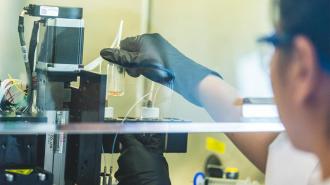For the first time, scientists have directly 3D-printed skin to heal open wounds — an achievement that could one day lead to less scarring following reconstructive surgery.
The challenge: Reconstructive surgery to treat trauma to the face or head can be life changing — not only can it restore crucial abilities, such as the ability to chew food, it can help avoid significant disfigurements, too.
Still, after the wounds from surgery heal, patients are often left with visible scars or permanent hair loss, which can have a negative impact on their self-image and mental health.
Skin, deep: Researchers at Penn State have developed a 3D bioprinting technique that, when directly applied to the wounds of rats, led to new, full-thickness skin — with the potential to grow hair — within two weeks.
After reconstructive surgery, patients are often left with visible scars or permanent hair loss.
To create their 3D-printed skin, the Penn State team started by loading three “bioinks” into separate compartments of a bioprinter.
Molecules and proteins extracted from donated human fat tissue — known collectively as the tissue’s “extracellular matrix” — filled one container. Another was loaded with stem cells pulled from the same fat tissue, and the third container was filled with a clotting substance to help the other two inks bind to the wound.
The researchers then precisely layered their bioinks directly onto rats’ head wounds to form the two innermost layers of human skin: the hypodermis and the dermis. Within two weeks, the third layer — the epidermis — had naturally regrown on top of the 3D-printed skin.
“It could result in a far more aesthetic outcome.”
Ibrahim T. Ozbolat
By then the researchers could also see downgrowths — the early stages of hair follicle formation — in the hypodermis layer, suggesting that they were on the right track to creating 3D-printed skin capable of growing hair.
“We are working to advance this, to mature the hair follicles with controlled density, directionality, and growth,” said lead researcher Ibrahim T. Ozbolat.
The big picture: Past research has shown it’s possible to 3D bioprint full-thickness skin in the lab, but this is the first study to print multiple layers of skin directly onto a living wound, and if the approach translates to people, it could lead to less scarring than traditional skin grafts.
“We believe this could be applied in dermatology, hair transplants, and plastic and reconstructive surgeries — it could result in a far more aesthetic outcome,” said Ozbolat.
We’d love to hear from you! If you have a comment about this article or if you have a tip for a future Freethink story, please email us at tips@freethink.com.
